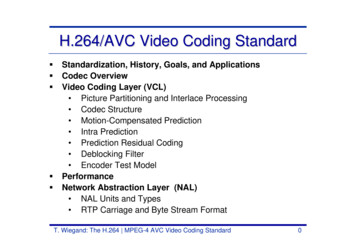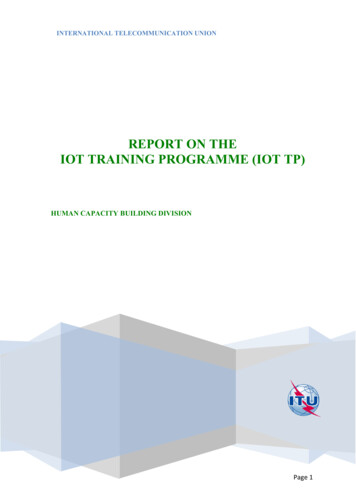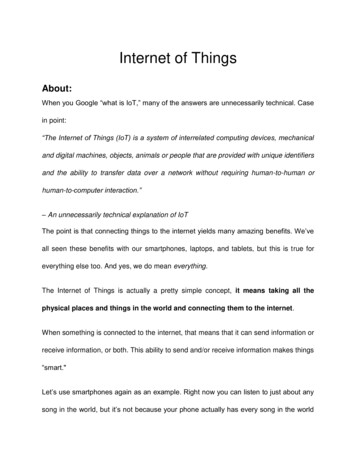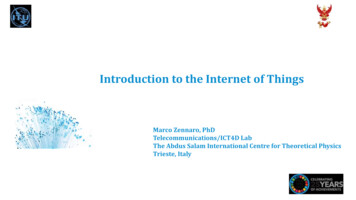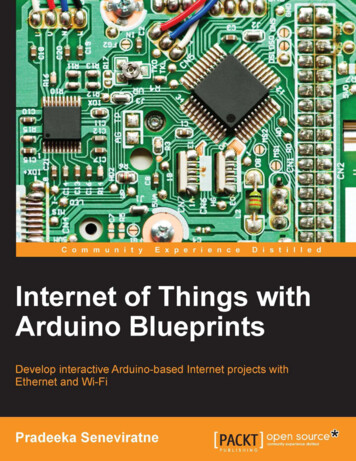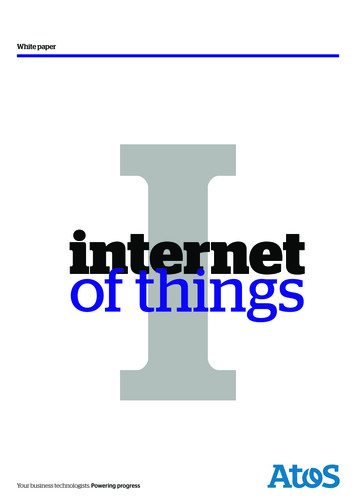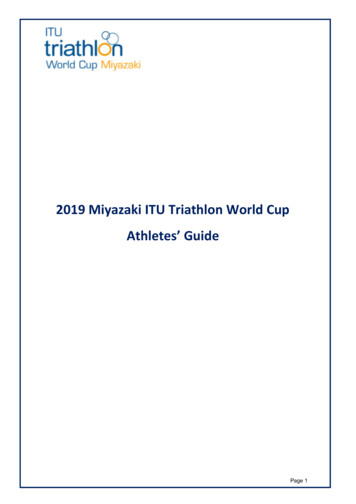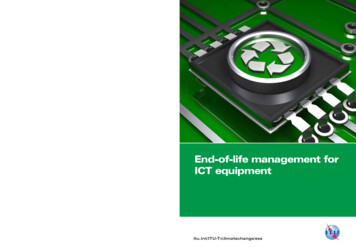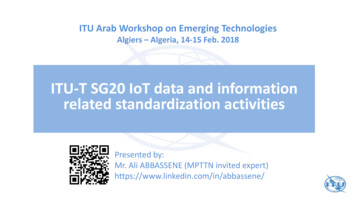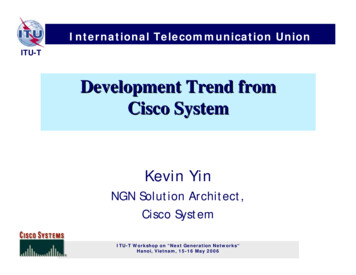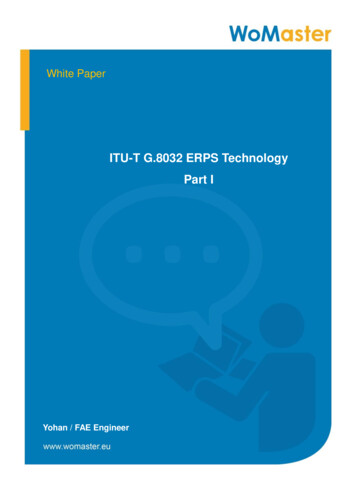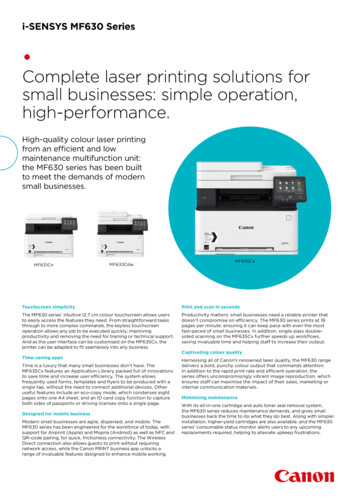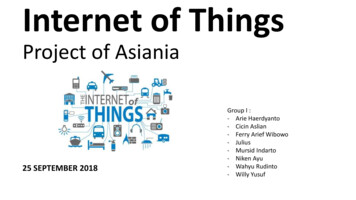
Transcription
Internet of ThingsProject of Asiania25 SEPTEMBER 2018Group I :- Arie Haerdyanto- Cicin Aslian- Ferry Arief Wibowo- Julius- Mursid Indarto- Niken Ayu- Wahyu Rudinto- Willy Yusuf
OUTLINE Country Background Problem and challenge TASKs Digital Society Program 2030 Analyze the ecosystem Chart clustering Conclusion2
COUNTRY BACKGROUND Middle income developing country. 20% area is mountain and difficult terrain, 50% fertile land. Population 2015 : 90 million, 2020 : 92 million, predicted 2030 : 100million. A new elected government has been very critical on primaryindustries. (e.g. agriculture, logistics, transport) The Prime Minister believes in the need for food security anddevelopment of primary industries while leveraging on ICTs.3
PROBLEM AND CHALLENGE Spectrum licenses come with strict technical requirementHigh license feeLess interest to invest in rural areaLack of focus on primary industries (agriculture, logistics, transport)Limited e government serviceData has been hacked in government departmentLack of clarity for consumer protectionNo mechanism for e-government and telco platforms to interoperatePollutionDigital data not well managed4
TASKs Provide recommendations on IoT and M2M issues to the governmentof Asiania with 2030 digital society program goals in mind. Prepare a chart with action plan for Asiania ICT Authority until 2021.5
DIGITAL SOCIETY PROGRAM 2030(Goals & Expected Outcomes) Well established digital infrastructure (nation wide)o Real time informationo Traffic reductiono Data is secured (easy to investigate) Knowledge based economyo Strong economy foundation Boosting all economic sectorso Small economic inequality gap Improvement of the enviromental conditions using ICTso Good weather conditiono Long life residents High digital skillso Easy to find or create a job6
ANALYZE THE ECOSYSTEMRegulator DiscussVendor/OperatorCustomer StakeholdersConsultation ExcecutionOperator7
SOCIETAL BENEFITS OF INTERNET OF THINGSEconomic nancialInclusionFacilitate eGovernmentINTERNET OF THINGS8
Recommendations Deep collaboration with telecommunication stakeholders (operators,vendors, universities, customers). Re-valuate license process and license fee. Analyze current telecommunication business figure. (investment goesup, no additional revenue) Socialize the benefits of Internet of Things. Raise fund for telecommunication sector. (incentive, innovation,public service)9
CHART CLUSTERINGInstitution & CoordinationTechnology, Spectrum, Standards, Infrastructure, interperabilityPrivacy and SecurityConsumer awareness and Consumer protectionKnowledge and ovation and Service10
CHART CLUSTERING1. Policy, Legislation and Regulation Tax Incentive for IoT device (sensors, equipment,etc).Invite and give incentive to invest in IoT device manufacturing.Use of Universal Service Fund for deployment at rural areas.Incentive for investment on primary industries. (agriculture, logistics, transport)Apply and make a better e-government services in all sector.Deployed public services based on ICT.Clustering area : beneficial, non beneficial area.Tax rebate for build in rural area.Allow use of unlicensed band to improve capacity.Fairness treatment for licensed and unlicensed spectrum.Ensure the level of Quality of Service.Simplify the telecommunication license regime.Street furniture policy.Data protection regulation.Roadmap for telecommunication evolution. (5G, 6G, NR, etc)11
CHART CLUSTERING2. Institution and Coordination Inter regional coordination. Inter ministrial / organization coordination. Collaborate with Universities.3. Technology, Spectrum, Standards, Infrastructure and Interperability Release more spectrum.Deadline for IPV6 migration.Simplify for certification process.Simplify or facilitate for IP tier1 transit operators.Allow and encourage network and infrastructure sharing.Unified IoT standard for Interperability.12
CHART CLUSTERING4. Privacy and Security Ensure equipments used are from trusted and verified equipment manufacturer.Standardization for cloud computing.Incentives for companies to build a new data security mechanism.Create national “clocking”.Integration of Cybersecurity.5. Consumer Awareness and Consumer Protection Education. Socialization. Survey for customer satisfaction and needs.6. Knowledge and Skill Education. Training.13
CHART CLUSTERING7. Competition Fairness tariff policy.8. Innovation and Service Incentive for laboratory.Innovation competition for colleges.Create data center.Green innovation project.Content Development Center.14
CONCLUSION1. Communication is needed to mobilize the supports fromall stakeholders.2. Regulation is needed to make sure the objective can beachieved on time.15
TIME CHART2018Policy, Legislation and Regulation Tax Incentive for IoT device (sensors, equipment,etc). Invite and give incentive to invest in IoT device manufacturing. Use of Universal Service Fund for deployment at rural areas. Incentive for investment on primary industries. (agriculture, logistics, transport) Apply and make a better e-government services in all sector. Deployed public services based on ICT. Clustering area : beneficial, non beneficial area. Tax rebate for build in rural area. Allow use of unlicensed band to improve capacity. Fairness treatment for licensed and unlicensed spectrum. Ensure the level of Quality of Service. Simplify the telecommunication license regime. Street furniture policy. Data protection regulation. Roadmap for telecommunication evolution. (5G, 6G, NR, etc) Improve the ITE Law.Institution and Coordination Inter regional coordination. Inter ministrial / organization coordination. Collaborate with Universities.Technology, Spectrum, Standards, Infrastructure and Interperability Release more spectrum. Deadline for IPV6 migration. Simplify for certification process. Simplify or facilitate for IP tier1 transit operators. Allow and encourage network and infrastructure sharing. Unified IoT standard for Interperability.Privacy and Security Ensure equipments used are from trusted and verified equipment manufacturer. Standardization for cloud computing. Incentives for companies to build a new data security mechanism. Create national “clocking”. Integration of Cybersecurity.Consumer Awareness and Consumer Protection Education. Socialization. Survey for customer satisfaction and needs.Knowledge and Skill Education. Training.Competition Fairness tariff policy.Innovation and Service Incentive for laboratory. Innovation competition for colleges. Create data center. Green innovation project. Content Development Center.201920202021
Thank you“Change : The only thingthat never changes.”- Heraclitus -16
Use of Universal Service Fund for deployment at rural areas. Incentive for investment on primary industries. (agriculture, logistics, transport) Apply and make a better e-government services in all sector. Deployed public services based on ICT. Clustering area : beneficial, non beneficial area. Tax rebate for build in rural area.
